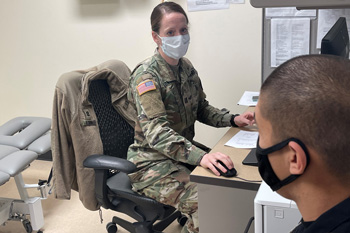 The physical therapy, medical, and Fitness Training Unit staff at Fort Leonard Wood, Missouri, serve approximately 80,000 Army trainees annually, providing on-site primary care and evaluation services at the Consolidated Troop Medical Clinic. (Photo: Lori Newman, U.S. Army)
The physical therapy, medical, and Fitness Training Unit staff at Fort Leonard Wood, Missouri, serve approximately 80,000 Army trainees annually, providing on-site primary care and evaluation services at the Consolidated Troop Medical Clinic. (Photo: Lori Newman, U.S. Army)
Responding to Injuries
Once injuries happen, the health care team at each training facility is there to help. At Fort Leonard Wood, the staff at the Richard G. Wilson Troop Medical Clinic offers primary care as well as physical therapy.
The installation has a fitness training holding unit for injured soldiers. That provides access to the Warrior Training and Rehabilitation Program, which helps injured soldiers rehabilitate and recover, said Army Maj. Jon-Marc Thibodeau, a clinical coordinator and chief of the medical readiness service line at Fort Leonard Wood.
"The soldier can continue healing while staying fit and healthy until they are ready to return back to training," explained Blondin.
For their part, medical providers can schedule individual briefs with a company or battalion to review injury prevention, discuss running form, or any other topic, Blondin explained. Physical therapists provide injured soldiers with crutches, braces, medication, manual therapy, exercises, stretches, dry needling, joint mobilization, or blood-flow restriction, among other treatments.
When necessary, orthopedic doctors may need to get involved for more significant injuries to assess the need for surgery.
Additionally, the trainees have access to behavioral health resources to address the psychological or emotional aspects of injuries.
"Behavioral health therapists or the chaplain are great resources to help these trainees figure out how to mentally cope with the stress and frustration of injury in the training environment."
Rest is Also Good
Advanced technologies help reduce and treat injuries from military training. But sometimes, the best treatment for training injuries can be as simple as rest, said Blondin.
If a trainee undergoes surgery or suffers significant injury, they may be granted convalescent leave and be allowed to return home temporarily. But this is an option military leaders prefer to avoid, as it takes the recruit out of the basic training environment.
"During convalescent leave, they don't have access to rehab. There's less of a safety control, and unfortunately, sometimes soldiers will get into trouble or lose their motivation to come back," said Blondin.
"Our first goal is to stay in training when safe and feasible," said Blondin. "Sometimes this can mean just taking it easy and modifying training for a week or two while things calm down."
Getting Back Into It
Following an injury, recruits gradually return to exercise. Close monitoring of their gait when performing exercises is key to ensuring trainees are ready to resume full training, said Thibodeau. Limping, for example, is an indication of injury and reveals it's not yet time to increase their running, walking, or rucking time.
"Going from zero to 100 is a recipe for re-injury," added Blondin. "Re-injury is tough in training, not only physically, but mentally. It can affect the ability to remain in the Army depending on the type and severity of the injury, and where they are in training."
Editor's note: Military services refer to entry-level service members as either 'recruit' or 'trainee'. Entry-level training also uses various names – 'basic training', 'recruit training' and 'boot camp' being the most common. For this article, theses terms are used interchangeably.